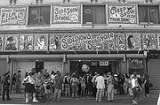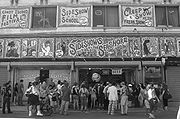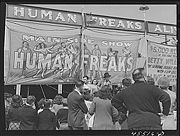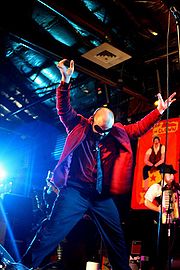
Freak show
Encyclopedia

Tattoo
A tattoo is made by inserting indelible ink into the dermis layer of the skin to change the pigment. Tattoos on humans are a type of body modification, and tattoos on other animals are most commonly used for identification purposes...
ed or pierced
Body piercing
Body piercing, a form of body modification, is the practice of puncturing or cutting a part of the human body, creating an opening in which jewelry may be worn. The word piercing can refer to the act or practice of body piercing, or to an opening in the body created by this act or practice...
people have sometimes been seen in freak shows, as have attention-getting physical performers such as fire-eating
Fire eater
A fire eater is an entertainer, often a street artist or part of a sideshow. The performer places flaming objects into their mouth and extinguishes them by cutting off oxygen. They also practice controlling and transferring the flame....
and sword-swallowing
Sword swallowing
Sword swallowing is an ancient performance art in which the performer passes a sword through the mouth and down the esophagus towards the stomach...
acts.
History

Circus
A circus is commonly a travelling company of performers that may include clowns, acrobats, trained animals, trapeze acts, musicians, hoopers, tightrope walkers, jugglers, unicyclists and other stunt-oriented artists...
es and carnivals
Traveling carnival
A traveling carnival is an amusement show that may be made up of amusement rides, food vendors, merchandise vendors, games of chance and skill, thrill acts, animal acts or sideshow curiosities. A traveling carnival is not set up at a permanent location, like an amusement park, but is moved from...
. Some shows also exhibited deformed animals (such as two-headed cows, one-eyed pigs, and four-horned goats) and famous hoaxes, or simply "science gone wrong" exhibits (such as deformed babies).
Changes in popular culture and entertainment, and changing attitudes about physical differences, led to the decline of the freak show as a form of entertainment. As previously mysterious anomalies were scientifically explained as genetic mutations or diseases, freaks became the objects of sympathy rather than fear or disdain. Laws were passed restricting freak shows for these reasons. For example, Michigan
Michigan
Michigan is a U.S. state located in the Great Lakes Region of the United States of America. The name Michigan is the French form of the Ojibwa word mishigamaa, meaning "large water" or "large lake"....
law forbids the "exhibition [of] any deformed human being or human monstrosity, except as used for scientific purposes". However, in many places freak shows are still popular features.
Historical timeline
The exhibition of human oddities has a long history:1630s: Lazarus Colloredo
Lazarus and Joannes Baptista Colloredo
Lazarus Colloredo and Joannes Baptista Colloredo were Italian conjoined twins who toured in 17th century Europe. They were born in Genoa, Italy....
, and his conjoined twin brother, John Baptista, who was attached at Lazarus' sternum, tour Europe.
1704–1718: Peter the Great
Peter I of Russia
Peter the Great, Peter I or Pyotr Alexeyevich Romanov Dates indicated by the letters "O.S." are Old Style. All other dates in this article are New Style. ruled the Tsardom of Russia and later the Russian Empire from until his death, jointly ruling before 1696 with his half-brother, Ivan V...
collected human oddities at the Kunstkammer in what is now St. Petersburg, Russia.
1738: The exhibition of a creature who "was taken in a wook at Guinea; 'tis a female about four feet high in every part like a woman excepting her head which nearly resembles the ape."
1884: Joseph Merrick
Joseph Merrick
Joseph Carey Merrick , sometimes incorrectly referred to as John Merrick, was an English man with severe deformities who was exhibited as a human curiosity named the Elephant Man. He became well known in London society after he went to live at the London Hospital...
, exhibited as "The Elephant Man" by Tom Norman
Tom Norman
Thomas Noakes, later known as Tom Norman, was an English businessman and showman. He started his working life as a butcher in Sussex and at 17 moved to London. After viewing an exhibition of an "Electric Lady" next door to his place of work, he went into business with the lady's manager and began...
in London's East End
East End of London
The East End of London, also known simply as the East End, is the area of London, England, United Kingdom, east of the medieval walled City of London and north of the River Thames. Although not defined by universally accepted formal boundaries, the River Lea can be considered another boundary...
.
1932: Tod Browning
Tod Browning
Tod Browning was an American motion picture actor, director and screenwriter.Browning's career spanned the silent and talkie eras...
's Pre-Code
Pre-Code
Pre-Code Hollywood refers to the era in the American film industry between the introduction of sound in the late 1920s and the enforcement of the Motion Picture Production Code censorship guidelines. Although the Code was adopted in 1930, oversight was poor and it did not become rigorously...
-era
Era
An era is a commonly used word for long period of time. When used in science, for example geology, eras denote clearly defined periods of time of arbitrary but well defined length, such as for example the Mesozoic era from 252 Ma–66 Ma, delimited by a start event and an end event. When used in...
film
Film
A film, also called a movie or motion picture, is a series of still or moving images. It is produced by recording photographic images with cameras, or by creating images using animation techniques or visual effects...
Freaks
Freaks
Freaks is a 1932 American Pre-Code horror film about sideshow performers, directed and produced by Tod Browning and released by Metro-Goldwyn-Mayer, with a cast mostly composed of actual carnival performers. The film was based on Tod Robbins' 1923 short story "Spurs"...
tells the story of a traveling freakshow. The use of real freaks in the film provoked public outcries, and the film was relegated to obscurity until its re-release at the 1962 Cannes Film Festival
Cannes Film Festival
The Cannes International Film Festival , is an annual film festival held in Cannes, France, which previews new films of all genres including documentaries from around the world. Founded in 1946, it is among the world's most prestigious and publicized film festivals...
.
1960: Albert-Alberta Karas (two siblings, each half man, half woman) exhibits with Bobby Reynolds on sideshow tour.
1992: Grady Stiles
Grady Stiles
Grady Franklin Stiles, Jr. was a freak show performer. His deformity was ectrodactyly, where the fingers and toes are fused together to form claw-like extremities. Stiles' stage name was the "Lobster Boy"....
(the lobster boy) is shot in his home in Gibsonton, Florida
Gibsonton, Florida
Gibsonton is an unincorporated census-designated place in Hillsborough County, Florida, United States. The population was 14,234 at the 2010 census....
.
1996: Chicago shock-jock Mancow Muller presented Mancow's Freak Show at the United Center in the Summer of 1996, to crowd of 30,000. The show included Kathy Stiles and her brother Grady III as the Lobster Twins. {Mancow Muller (with John Calkins) Dad, Dames, Demons & a Dwarf Regan Books 2004 pp. 121, 137-147}
2000–2010: Ken Harck's Brothers Grim Sideshow debuted at the Great Circus Parade in Milwaukee, WI. The Milwaukee run included a fat lady and bearded lady Melinda Maxi, as well as self made freaks The Enigma and Katzen. In later years the show has included Half-boy Jesse Stitcher and Jesus "Chuy" Aceves the Mexican Werewolf Boy and Stalking Cat. Bros. Grim toured with the Ozz Fest music festival in 2006,2007 and 2010.
2005: "999 Eyes Freakshow" founded, touting itself as the "last genuine traveling freakshow in the United States." 999 Eyes portrays freaks in a very positive light, insisting that "what is different is beautiful." Freaks include Black Scorpion
Black Scorpion (performer)
The Black Scorpion also known as a Lobster Boy, is a freak show and sideshow performer, known for his bizarre and surreal stage performances, bandit mask, multi-colored self-designed shoes and Ectrodactyly of his hands and feet.The Black Scorpion performs as a freak working to change the word...
.
2007: Wayne Schoenfeld
Wayne Schoenfeld
Wayne Schoenfeld is an American photographer best known for his coverage of global humanitarian projects, as well as his art photography.- Photography :...
bring together several sideshow performers to "The L.A. Circus Congress of Freaks and Exotics," to photograph sideshows folks for "Cirque Du Soleil - Circus of the Past." In attendance were: Bill Quinn, the halfman; Percilla, the fat lady; Mighty Mike Murga the Mighty Dwarf; Dieguito El Negrito, a wildman; fireeaters; sword swallowers, and more.
Modern freak shows

BodyShock
BodyShock is a sensationalistic documentary series about the conditions or lives of extraordinary people. It was originally produced by redback for Channel 4 in the UK, but since September 2006, it has been carried by ArkMedia....
show the life of severely disabled or deformed people, and can be seen as the modern equivalent of the circus freak shows. However in order to make the shows respectable, the subjects are usually portrayed as heroic and attention is given to their family and friends and the way they help them overcome their disabilities. On The Guardian
The Guardian
The Guardian, formerly known as The Manchester Guardian , is a British national daily newspaper in the Berliner format...
, Chris Shaw however comments that "one man's freak show is another man's portrayal of heroic triumph over medical adversity" and carries on with "call me prejudiced but I suspect your typical twentysomething watched this show with their jaw on the floor rather than a tear in their eye".
Further reading
- Martin Monestier, Human Freaks, encyclopedic book on the Human Freaks from the beginning to today. (In French: Les Monstres humains: Oubliés de Dieu ou chefs-d'œuvres de la nature)
External links
- Showhistory.com
- Shocked and Amazed - periodical devoted to sideshow and variety entertainment
- Freaks and prodigies - Section of Monstrous.Com dedicated to freaks and prodigies
- Sideshow World - "Preserving the past... promoting the future"
- Congress of Oddities: James G. Prodigies - freakshow ephemera from the collection of artist James G Mundie

